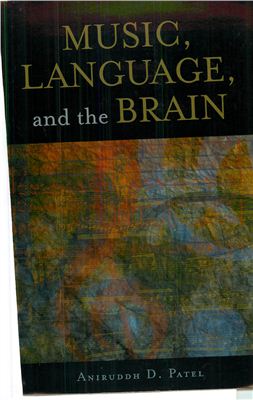New York: Oxford University Press, 2008). (ISBN13:
978-0-19-512375-3 ISBN10: 0-19-512375-1, Hard cover,
528 pages
(scanned book)
The book starts by reminding us that the interest in
music-language relations is over 2000 years old (going back to Plato) and has now led cognitive scientists to ask how the brain deals with these two domains:
Are cognitive and neural correlates domain-speciic
or common to music and language processing? Patel’s aim is to look systematically at various aspects of both domains and to present similarities and differences between the two systems. The emphasis, however, is on the search for commonalities: Even
if the two systems have speciic features and representations, he analyzes the extent to which these differences might relect the same domain-general
processes. In searching for commonalities rather
than differences in processing mechanisms, Patel’s
comparative study of music and language investigates how the brain makes sense out of sound (p. 417) in a parsimonious way (e.g., by sharing structural processing and separating representations).
While this represents Patel’s favored approach, he also reviews research showing domain-speciicity and attempts to integrate these data in a framework of
shared processing.
A metaphor illustrates this when
he discusses dissociations in patients showing selective music and language deicits (see p. 73): If a factory manufacturing both cars and motorcycles catches
ire that damages only one warehouse (e.g., the one
for cars), this does not tell us anything about the overlap in tools used for the construction of both vehicles.
Patel’s book reviews research and approaches to
investigate the possible overlap in cognitive and
neural correlates of music and language processing.
The book provides a
thorough state-of-theart review of recent
studies and ongoing
debates on music, language, and the brain.
Patel presents emerging
questions and new studies that provide at least
partial answers or add
new questions, stimulating future research.
He communicates his
curiosity and interest in
studying music and language processing to understand how the brain deals
with structured sound systems.
The book is organized to start with small units
(i.e., sound categories, Chapter 2), goes on to discuss larger structural regularities (based on pitch
and time respectively, Chapters 3 and 4), which leads
to syntactic structures (Chapter 5) and then ends
with questions related to meaning (Chapter 6) and
evolution (Chapter 7). Avoiding the pitfall of supericial analogies between music and language, Patel
is careful with deinitions and restrictions of his discussions and interpretations: He does not attempt
to be all-encompassing, aiming for precision rather
than vague generalization. For example, the book
focuses on instrumental music and ordinary spoken
language, a choice justiied for the investigation of
common cognitive and neural mechanisms.
At appropriate places, the book also includes interludes
that focus on other art forms, such as sung music
and poetry (Chapters 3 and 6), when this serves the
purpose of understanding brain function.
978-0-19-512375-3 ISBN10: 0-19-512375-1, Hard cover,
528 pages
(scanned book)
The book starts by reminding us that the interest in
music-language relations is over 2000 years old (going back to Plato) and has now led cognitive scientists to ask how the brain deals with these two domains:
Are cognitive and neural correlates domain-speciic
or common to music and language processing? Patel’s aim is to look systematically at various aspects of both domains and to present similarities and differences between the two systems. The emphasis, however, is on the search for commonalities: Even
if the two systems have speciic features and representations, he analyzes the extent to which these differences might relect the same domain-general
processes. In searching for commonalities rather
than differences in processing mechanisms, Patel’s
comparative study of music and language investigates how the brain makes sense out of sound (p. 417) in a parsimonious way (e.g., by sharing structural processing and separating representations).
While this represents Patel’s favored approach, he also reviews research showing domain-speciicity and attempts to integrate these data in a framework of
shared processing.
A metaphor illustrates this when
he discusses dissociations in patients showing selective music and language deicits (see p. 73): If a factory manufacturing both cars and motorcycles catches
ire that damages only one warehouse (e.g., the one
for cars), this does not tell us anything about the overlap in tools used for the construction of both vehicles.
Patel’s book reviews research and approaches to
investigate the possible overlap in cognitive and
neural correlates of music and language processing.
The book provides a
thorough state-of-theart review of recent
studies and ongoing
debates on music, language, and the brain.
Patel presents emerging
questions and new studies that provide at least
partial answers or add
new questions, stimulating future research.
He communicates his
curiosity and interest in
studying music and language processing to understand how the brain deals
with structured sound systems.
The book is organized to start with small units
(i.e., sound categories, Chapter 2), goes on to discuss larger structural regularities (based on pitch
and time respectively, Chapters 3 and 4), which leads
to syntactic structures (Chapter 5) and then ends
with questions related to meaning (Chapter 6) and
evolution (Chapter 7). Avoiding the pitfall of supericial analogies between music and language, Patel
is careful with deinitions and restrictions of his discussions and interpretations: He does not attempt
to be all-encompassing, aiming for precision rather
than vague generalization. For example, the book
focuses on instrumental music and ordinary spoken
language, a choice justiied for the investigation of
common cognitive and neural mechanisms.
At appropriate places, the book also includes interludes
that focus on other art forms, such as sung music
and poetry (Chapters 3 and 6), when this serves the
purpose of understanding brain function.

